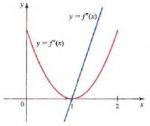Use the graphs of f' and f'' to find critical points, inflection points, intervals on which f is increasing and decreasing, and intervals of concavity, then graph f assuming f(0)=0
(f' is in red, f'' is blue line)
View attachment 4572
here's what i see so far: (0,1) f'<0 Decreasing Concave up f''>0, (1,2) f'>0 increasing concave up f''>0.
I'm having trouble understanding the line f'' and how to interpret it. Any help is greatly appreciated. Thanks!
These are hard. You're kinda trying to go backwards from the picture. :shock:
Where the function is decreasing, the derivative is negative; where the function is increasing, the derivative is positive; there the function is horizontal (or has a critical point), the derivative is zero.
Working backwards: Where the derivative is negative, the function is decreasing; where the derivative is positive, the function is increasing; where the derivative is zero, the function is horizontal (or there's a critical point).
In your graph, is the derivative ever negative? So is the function ever decreasing? (Note: "Increasing at a slower rate" is
not the same as "decreasing"!) Is the derivative ever zero? Where? So where is the function horizontal?
Where the function is concave up, the second derivative is positive; where the function is concave down, the second derivative is negative; where the function has an inflection point, the second derivative is equal to zero.
Working backwards: Where the second derivative is positive, the function is concave up; where the second derivative is negative, the function is concave down; where the second derivative is zero, the function has an inflection point.
In your graph, is the second derivative ever negative? If so, where? So is the function ever concave downward? Same questions for positive and zero.
Doodling, I come up with:
Code:
f':
increasing, but by less and less,
followed by
increasing, and by more and more:
- - ' /
- ' /
-' followed by -'
/ - '
/ - - '
...and:
Code:
f'':
concave down,
inflection point, and
concave up:
- - -ish, /
- ' ' -
/ followed by ' - - '
See what you can come up with, based on these bits and pieces. ;-)


